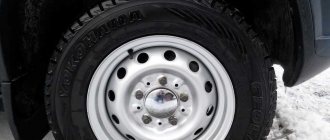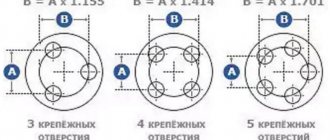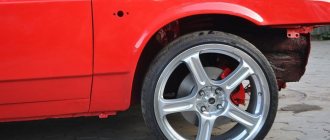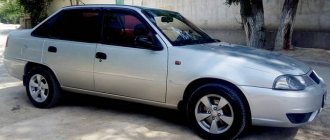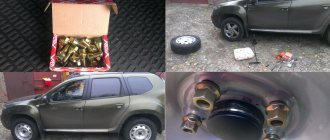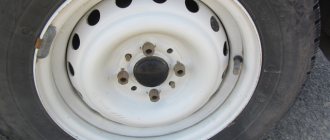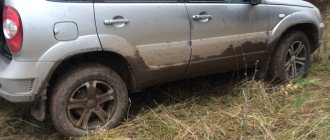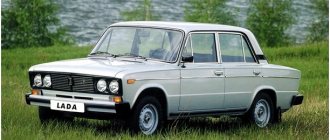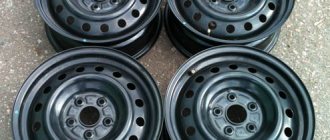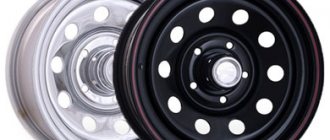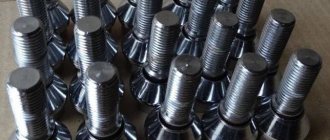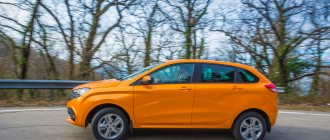Author: Kot shashlik
October 20, 2015 10:58
Tags: USSR Koelsa Muscovites Soviet auto industry
18331
23
The cars of the Moscow Automobile Plant are as much a part of the history of the Soviet automobile industry as the production association itself. Nevertheless, many of the Muscovites are still in service and are putting more and more kilometers on their bias-ply (and not so bias-ply) tires.
0
See all photos in the gallery
Disc labeling
So, let's say you have a disk that displays the following information: 7.5 Jx16 H2 5/112 ET 35 d 58.5
. Let's look at each of the available notations.
7.5Jx16
, the first three, informs us that W - the rim width of this disk - is 7.5 inches (we must remember that almost all disk parameters are indicated in inches: 1 inch = 2.54 cm), D - diameter - is 16 inches, and also that this disk is not stamped/one-piece (“x” is the icon for cast and forged wheels).
Letter J
It’s also in this set for a reason. This letter indicates that the edges of the rim are intended for single-wheel drive cars, so if, for example, your car is all-wheel drive, the discs in question do not fit it and you need to look for identical ones, but with a different marking - JJ.
H2
carries information rather for specialists and informs them that the rim has 2 humps (ring protrusions) necessary to keep tubeless tires from slipping. Naturally, if there is only 1 such protrusion, it will be marked H1 on the marking. It is also possible that there will be a complete absence of such protrusions or their presence, but in a special design, when the symbols will be slightly different (AN, FH, CH). One way or another, for an ordinary motorist this parameter is practically unimportant, which cannot be said about the following numbers.
5/112
- this is a chatterbox. 5 is the number of landing bolts and holes for them, and 112 is the diameter of the circle on which these holes are located, and it is measured not in inches, but in millimeters familiar to a Russian person. There are three ways to find out the disc bolt pattern:
, however, more on this a little later, but for now let’s look at the remaining parameters.
Marking ET 35
indicates disc ejection. In this example, it is 35 mm; in principle, the offset is the distance between the axis of symmetry of the product and the plane of application of the disk to the hub. When the pressing plane is equal to the center of the disk, then the offset is called zero, when it protrudes beyond the limits, it is negative, and when, on the contrary, the center of the disk is closer to the hub than the plane of application of the disk, such an offset is called positive.
d 58.5
is the diameter of the central hole. When it does not coincide with the diameter of the seat cylinder on the car hub, then it is not at all necessary to look for new disks; you can simply buy an additional set of spacer rings, and then use them to adjust the said elements.
How discs are marked
Each disc has an individual marking indicating:
•number of holes for mounting to the hub;
•diameter of a conventional circle passing through the axes of these holes;
Wheel rim bolt pattern compatibility table
Let's look at an example of full marking 9JX16 Н2 5/112 ET 35 D 66.6
9 – disk width (in inches);
J – designation indicating that the disk is intended for a one-wheel drive car (wheels for all-wheel drive vehicles are designated by two letters JJ);
X – disc manufacturing method (cast);
16 – installation diameter (in inches);
H2 – marking indicating the number of annular protrusions holding the tubeless tire (2);
5/112 – number of mounting holes/diameter of the circle on which they are located (bolt pattern);
ET 35 – disc offset value (in millimeters);
D 66.6 – diameter of the central (hub) hole of the disk.
Do-it-yourself tuning Moskvich 412: selection of photos
Dimensions and bolt pattern of BMW 3 series rims
To help you figure out whether you can do the tuning of a Moskvich 412 with your own hands, an example is given below. One car owner purchased the above-mentioned 1981 car in poor condition and began remodeling it.
The gearbox was taken from a Chevrolet Niva 0.83 with fifth gear. I lightened the elbow in the engine by 2 kg, then installed a stationary one with counterweights. I didn’t touch the connecting rods: if you don’t have accurate scales, then you shouldn’t meddle. I cut off the skirts and piston bottom by 2 mm (measurements were taken using water and a syringe). I installed a piston from a Volga with a coating. I filed the head down to 1.7 mm. I bored out the channels so that the standard ones ran along the entire length. I left the valves standard with an intake of 39.5. 78 camshaft Zhiguli springs, classic; 2 mm washers under the springs. Reduced the weight of the valve plate. Chamfer – 30 degrees. I cut off the guides in the channels. I cut the gear. Flywheel 4 kg. I installed 2 horizontal carba-solex (magpies). Engine tuning is ready. Volume came out 1.9, power - 125 hp
To make car repairs easier, pay attention to the photo:
Interior
What is wheel bolt pattern?
Until 1968, the car was supplied in the front part of the cabin with a sofa-type seat, which had separate backrests. A little later, separate seats began to be installed on the car, both for the driver and for the passenger sitting next to him.
In both variations, the backrests of the seats were able to fold, creating a berth. Inside the Soviet sedan, they decided to trim the interior with leatherette in the color of the body, while its coloring options are different, and the plastic parts used inside the car began to be used less.
Original sofa seat
For example, already at the onset of 1966, the dashboard began to have soft plastic overlays - they decided to do this in order to increase the level of safety for the driver and the passenger sitting next to him.
Already in ’79, plastic linings were placed on the body pillars, and in ’71, the instrument panel was already decorated with a solid plastic lining. The heating system was already able to take in air both inside and outside the cabin.
In addition, it was possible to significantly increase the efficiency of the heating system by significantly increasing the active surface of the heat exchanger.
On top of that, heat inside the sedan was better distributed thanks to a six-bladed fan, which was driven by a powerful electric motor. The luggage compartment of the new car did not have such a large volume - 372 liters. The car also had a low loading height.
This minus significantly reduced the convenience of its use. The design staff also decided to place the spare tire flat on the bottom of the trunk, on the left side, which only took up even more of the already small volume.
Due to the wheel wells protruding towards the passenger compartment, it was quite uncomfortable for three adult passengers to sit on the back seat. But the legs of the driver and the passenger sitting in front were more spacious than, for example, in the Zhiguli, since the wheel wells were moved forward.
Moskvich-412 – video test drive
What is wheel bolt pattern and how to measure it
Muscovites did not copy the Bavarians - they only adopted a number of advanced solutions. An aluminum cylinder block, hemispherical combustion chambers, and an overhead camshaft with a chain drive provided advanced, by world standards, power output. Thanks to replaceable cylinder liners, during a major overhaul the engine did not need to be bored using complex equipment—it was enough to just replace the liners. The full bearing crankshaft ensured smooth operation and low noise. In addition, the engine had an unusual layout with an inclined cylinder block for compactness and a lower center of gravity.
For the first time in the USSR, this engine was equipped with a quick-change air filter, which every car now has. The engine design was fine-tuned on the Moskvich-G4 M racing car. Master of Sports V. Shchavelev took 4th place in it at the 1966 USSR Championship in circuit racing. The Moskvich-412 car was not a replacement for the Moskvich-408, but a slightly belated luxury version. Compared to the basic version, acceleration, efficiency, and top speed have improved. Moskvich-412 remained the fastest production Soviet car until the appearance of the VAZ-2103 in 1972.
Moreover, MZMA's developments in the field of engine building influenced the work of the new Volzhsky Automobile Plant. At the insistence of Moscow engineers, who were involved in the evaluation and modernization of the Fiat 124 (the future VAZ-2101), Fiat agreed to rework the engine from a lower camshaft to an upper one, that is, to modernize it. A more powerful engine required changes to other components of the Moskvich-412 compared to the 408. For the first time in the USSR, the 412th had a gearbox with a floor lever and synchronizers on all four stages, and a hydraulic vacuum brake booster.
There was a catastrophic shortage of “Muscovites”, so since 1967 their production was also mastered at. Since that time, the evolution of the model has proceeded independently in Moscow and Izhevsk. For example, it was believed that Izhevsk “Moskvich” cars had a higher build quality. But the Moscow “Moskvich-408” and “Moskvich-412” were modernized in 1969 to meet European safety requirements, receiving a new body with a different power structure, a safety steering column, separate front seats, seat belts, soft interior trim, and a rear mirror view with night mode and other improvements. At the same time, rectangular headlights of European standard began to be installed on Moskvich. It must be said that VAZ introduced similar headlights only in 1979.
Moskvich-412 became the first Soviet car to pass a crash test in France. Not only VAZ, but also MZMA/AZLK widely used foreign developments. Thus, the Moskvich-412 had a licensed clutch with a diaphragm spring (for the first time in the USSR) and a brake system developed in England. Moreover, in the early 1970s. Both AZLK and Izhmash were completely rebuilt to Renault assembly technologies, after which they reached a capacity of up to 200 thousand units. per year each. Until the mid-1970s. Moskvich-412 sold well all over the world, not least due to its sporting fame. Sales increased sharply after the 1968 London-Sydney rally, in which the Soviet car showed its reliability. The success of the Moskvich is primarily associated with a reliable and unpretentious design with a large margin of safety. Moskvich-412 became the last car from the USSR to achieve success in world sports.
The model was produced at AZLK until 1976 and came off the assembly line almost simultaneously with the “junior” Moskvich-408. By this time, the car had lost ground both in sports and in exports. Over the years, foreign dealers made more and more of their own modifications to make Soviet cars meet the requirements. As for Izhmash, which worked mainly for the domestic market of the country, it produced its version of the 412 until 1994.
Selection of rims for Moskvich 2141
However, popular modern cars are not equipped with wheels of this size. The closest to these indicators are common disks with a PCD of 114.3 mm. Japanese and Korean cars are equipped with such wheels, for example, some Mazda, Mitsubishi, Hyundai models.
The existing difference of 0.7 mm in the diameter of the circle where the fastening bolts are located can be neglected, since each hole is shifted relative to the center by 0.35 mm, which is compensated by the conical fit of the fastening nuts. If the wheel offset is greater - for example, 35 mm, it turns out to be recessed 5 mm into the “depth” of the arches, due to which the low “Moskvich” cutouts (at the rear) do not interfere with the normal rotation of the wheels. It is not recommended to use wider tires, since in this case the gap between the rear wheel and the spring on one side, and the wing on the other, will be unacceptably small. However, finding wheels less than 5.5 inches wide will not be easy, since five-stud hubs today are only equipped with heavy and powerful cars, which are not equipped with narrow wheels.
When purchasing and installing “castings” on “Moskvich” models 412 and 2140, you should take into account that such disks, as a rule, have a large thickness in the mounting plane, so the length of the standard studs may not be enough and you will have to order extended ones from turners. In this case, the operation of fastening the disk should be treated more responsibly, strictly observing the sequence of tightening the nuts according to the “star” pattern. Discs with cylindrical rather than tapered holes may work without stud extensions because their special extended nuts allow them to "grab" the threads deep into the disc. However, their use in this case is undesirable - problems with wheel alignment may arise.
Finally, you need to pay attention to the diameter of the hole for the hub in the disk - the DIA parameter. For “native” Moskvich wheels it is 74 mm, and for many alloy wheels it is less
As a last resort, in order to seat the disc on the thickened part of the hub, you can chamfer the inside of the hole on the mating plane of the disc or bore the central hole on a machine.
OverviewCharacteristics The AZLK-2335 Moskvich passenger pickup truck was created in the early 1990s. Based on...
There is a lot of junk from the 41st, mainly interior elements and electrical equipment, if anyone needs anything...
VAZ-2106 engine The VAZ-2106 engine was developed by the Volzhsky Automobile Plant based on the VAZ-2103 power unit for the new…
Tuning Moskvich 412: car transformation Tuning the Moskvich carMoskvich tuning appeared quite a long time ago, back in the days...
One of the wheel rim parameters is the bolt pattern. Each manufacturer of foreign cars determines the value of the bolt pattern of wheel rims only for their own or standard rims, while for non-original vehicles this parameter differs by a fraction of a millimeter.
Is it important? What are fractions of millimeters? However, when installing “non-standard” rims, fractions of millimeters play an important role while driving. Remember, it is necessary that the wheel bolt pattern readings exactly match the factory dimensions of your wheels.
Replacing original wheels Moskvich-2141
Many owners are thinking about replacing standard Moskvich-2141 wheels with models from other cars or completely new ones. And the reason here is not only the desire to tune your car, but also the difficulties in finding “original” parts. And in markets and stores today they offer a wide range of products, both new and used, both steel and light alloy. But you need to figure out what kind of wheels can be installed on the Moskvich-2141 so that there is no harm to traffic safety.
The manufacturer gave the following recommendations regarding wheels for Moskvich-2141 . Tire sizes are 165/80 R14, 175/70R14, 185/70R14 and 185/65R14. In this case, steel wheels must have a 5J rim with an ET offset of 45 mm. A 5.5J rim with a 42mm offset is also allowed. Alloy wheels for Moskvich-2141 must have a 5.5J rim and an offset of 37 mm or a 6J rim and an offset of 33 mm. Note that the plant also allows the installation of tires 175/65 R15, as well as 185/65R15. In this case, the wheels must be 5.5J or 6J, and the offset must be 42 mm. It is worth paying attention to one nuance. If wheels are installed on a Moskvich-2141 with a profile width of 185 mm, such a wheel may not be mounted in the “original” fastener for the “spare tire” or in the niche for it.
In addition to the parameters described above, when selecting wheels for Moskvich-2141, mounting holes are also a decisive factor. This machine has 4 mounting holes with a circumference of 108 mm. In addition, it is important that the diameter of the central hole of the wheel rim is about 1-2 mm larger than the diameter of the hub. For the AZLK-2141 car, the latter is 52 mm.
If we talk about the selection of wheels for Moskvich-2141 from foreign cars, then here you can make a whole list of models. It will include Alfa Romeo 75 7th generation, Audi 80, 90, 100 until 1991, Ford Escort, Taunus, Cortina, Scorpio after 1995, Mondeo 1996-2000, Focus 1st generation, Cougar, Fiesta 3, 5 generations, as well as 4 generations until September 2008. In addition, wheels from many models of Peugeot and Citroen, SAAB 9000 1988-1992, Kia Alegro, Porsche 924 are suitable. Naturally, when selecting wheels for Moskvich-2141 , you may encounter the problem of discrepancy between the diameters of bolt or hub holes. The first ones can be drilled out if necessary. If they are more than required, then it is better to refuse such a purchase. In the case of hub holes, if it is larger on the disk than the diameter of the hub, then this is not critical. If it is less, then in this case it is also better not to purchase such disks.
What kind of bolt pattern for Moskvich 2141
for Moskvich 2141 Svyatogor, the simplest, and to fit the set of tires I have 175/70 r14 I looked on the internet - all the disks there have some 4 parameters: well, diameter (14) and number of holes * width (4 * 108 - for me ) - I kind of understood that. And what about the other 5.5-6.5J and et33-47 (all kinds in general). What does this mean and which ones will never suit me? Or maybe just come to the market/shop and say give me the simplest wheels for such and such a car with such and such tires? In this case, where is it better to go? and approximately how much will it cost?
For cars of the 2141/2142 families, the plant allows the installation of tires of dimensions 165/80R14, 175/70R14, 185/70R14 and 185/65R14 on steel wheels with a 5J rim, with an offset (ET) of 45 mm, or 5.5J with an offset of 42 mm, as well as light alloys with a 5.5J rim, with a 37 mm offset or 6J with a 33 mm offset
At the same time, the plant draws the attention of consumers that tires with a profile width of 185 mm may not fit in the standard niche or hanging spare wheel holder of the 2141 car. In addition, it is allowed to install tires of dimensions 175/65R15 and 185/65R15 on wheels with a rim of 5.5J or 6J, with 42 mm offset for both
Discs with a different rim or offset touch the arches or come out of them, so these parameters should be strictly adhered to
On Auto.ru all the parameters are written down, with pictures of what, where and why.
Thank you btw, in the first half of the day auto.ru for some reason did not work for me.
Discs with a different rim or offset touch the arches or come out of them, so these parameters should be strictly adhered to
Ok, I understand that, but will tires 177/70 r14 fit on any wheels with the recommended parameters?
/70 r14 of course, I got confused. Well, I already have both summer and winter tires - they just said in the spring that the wheels are crappy, they balance very poorly because of this - so I want to buy new ones.
The camp used to sell stampings for 2141, and if you need casting, then 175/70R14, with a 5J rim, with an offset (ET) of 45 mm, or 5.5J with an offset of 42 mm, that’s all. less than 175/70 don’t take 175/65 on this car they look like they come from a baby stroller.
wheels on 2141
| Page 1 of 1 | [Messages: 5] |
| print version | Prev. topic | Track. subject |
| Author | Message |
| Mac9n9 |
Registered:
14 Feb 2010, 18:31
Messages:
2
From:
Crimea
| Newbie |
| to come back to the beginning |
| MedvA |
Registered:
15 Oct 2007, 20:29
Messages:
244
From:
Ukraine, Uzhgorod
Car model:
azlk 21412
Mac9n9
Quote from Alexey Dzhigurda’s answers to ZR magazine (with comments):
Question: What sizes of wheels and tires are allowed to be installed on AZLK vehicles?
Answer: For cars of the 2141/2142 families, the plant allows the installation of tires of dimensions 165/80R14, 175/70R14, 185/70R14 and 185/65R14 on steel wheels with a 5J rim, with an offset (ET) of 45 mm, or 5.5J with an offset of 42 mm, as well as light alloys with a rim 5.5J, with an offset of 37 mm or 6J with an offset of 33 mm. At the same time, the plant draws the attention of consumers that tires with a profile width of 185 mm may not fit in the standard niche or hanging spare wheel holder of the 2141 car. In addition, it is allowed to install tires of dimensions 175/65R15 and 185/65R15 on wheels with a rim of 5.5J or 6J, with a 42 mm offset for both.
Published in issue 11, 2001.
Comment: The answer lists only the applicable and recommended tire and wheel sizes from among those approved. Not mentioned here are tires of size 195/60R15 (additionally certified at the request of the plant management to ensure the possibility of completing vehicles on special orders), the use of which, in principle, is not technically justified and is associated with a number of additional requirements for the vehicle (no lockers and strict compliance with the recommended wheel offset). On the other hand, the use of 185/65R14 tires and alloy wheels with an offset of 33 mm, although approved by the factory, is not recommended: first, due to a noticeable distortion of the speedometer readings and (critical for cars with a Renault engine) reduction in ground clearance, second — due to the reduction to zero of the negative rolling arm of the steered wheels and non-optimal loading of the wheel bearings, which negatively affects their service life. The plant envisions a comprehensive transition to 15-inch wheels, along with new brakes and hub assemblies with a different socket from the existing one. The plant did not select 15″ wheels that are interchangeable with the existing 14″ wheels (with 4x108 socket) and, accordingly, cannot give specific recommendations on where to get such wheels. When independently selecting wheels from among imported analogues, it should be taken into account that for tires of all sizes the recommended wheel offset is 42 mm. When using light alloy wheels, due to the possibility of their thicker and wider rim interfering with suspension elements, it is allowed to reduce the offset to the mentioned values (with the caveat that an offset of less than 37 mm can significantly reduce the service life of wheel bearings). When installing wheels with an offset beyond the range of 33-45 mm, factory specialists do not guarantee that the wheel assembly will not cling to chassis elements and will fit into the body arch in the event of suspension breakdowns, nor do they guarantee that the vehicle will have acceptable handling. It should be noted that with all currently recommended tire sizes, the possibility of using snow chains is not guaranteed (during the development of the car, this was provided only for the then basic tires of size 155/80R14 on a basic steel wheel with a rim width of 5 inches and an offset of 45 mm).
_________________ AZLK 21412-01 Central lock
UFA 1.5 BSZ, Solex 21041, 1990 . perform a dance with a tambourine counterclockwise around the car... it all depends on the degree of your mania.
Posts 1 page 4 of 4
Share12008-12-24 23:56:07
Wheel size for classic Moskvich 5x115-40 5 bolts, radius 115 mm, offset 40 mm.
IMHO, (I have an opinion you can’t argue with) Casting is a double-edged sword.
if, when flying into a hole, the stamped disk takes the blow and becomes dented (new 450-500r), then the durable cast disk will transfer the entire force of the impact to the suspension.
Balls and levers can “fly” and the geometry of the body can “go”.
I would not recommend alloy wheels in the Russian Federation. Only stamped ones.
I am against the use of disks not recommended by the factory, because... this affects: 1. Security. 2. On handling (increased effort on the steering wheel) 3. On the life of suspension and chassis elements: balls, bearings, steering joints, etc.
Therefore, I recommend the factory sizes.
Regarding alloy wheels, let me remind you that if you hit a hole/pothole, the stamped wheel will bend, softening the impact and not transferring it to the suspension and body elements.
It is cheaper to buy a new disk than to edit the body geometry or change suspension elements.
For small deformations, the stamped disc can be straightened with a hammer.
A cast disc is more durable and will not bend, but will transfer the shock to the suspension and body.
If you want to give it a beautiful look, use plastic decorative caps. There are a lot of them in stores now.
On bad roads, they are additionally insured by tying them with clamps or thin wire to the wheel rim so that they do not fly away.
Share32008-12-26 23:48:43
Wheel installation parameters, recommended tire size
HELP (table of wheel fit sizes and tire parameters)
You can find out the installation parameters of wheels (fitting dimensions, distance between holes, hub diameter, etc.) for AZLK cars, as well as the recommended tire size.
Wheels Tires 2140.412 155/80R13 n.d. 165/70R13 165/80R13
Share42008-12-26 23:50:44
Alloy wheels for Moskvich 412
For rear-wheel drive Moskvich models, alloy wheels can be selected without any problems. In this case, it is necessary to comply with some conditions - “Muscovites” are ideally suited for disks in which the mounting holes are located on a circle with a diameter of 115 mm (PCD), and the offset is 30 mm (ET). However, popular modern cars are not equipped with wheels of this size. The closest to these indicators are common disks with a PCD of 114.3 mm. Japanese and Korean cars are equipped with such wheels, for example, some Mazda, Mitsubishi, Hyundai models.
Discs
0
Tracing its pedigree from Opel, the Moskvich model 400/401 was equipped with narrow 4.50-16 or 5.00-16 tires. Today, such “shoes” are of interest only to restorers. However, it was radically different from other cars of those years in the design of its wheels: the cast-iron brake drum simultaneously served as both the hub and the wheel disk, and the mounting studs were spaced apart to the maximum possible diameter. Therefore, the wheel was actually devoid of a hub and consisted only of a rim with sockets for fastening nuts. The entire structure was covered with a convex chrome cap. Starting with the 402 model, there was a transition to a smaller diameter, and the seat of the wheel on the hub did not subsequently change for Muscovites until the advent of the front-wheel drive model 2141! This means that “theoretically” any wheel from any rear-wheel drive Moskvich starting from 402 can be installed on any Moskvich up to the late 2140. In practice, a disc brake caliper will prevent this.
×
0
0
0
0
0
True, the rim of models 402, 403, 407 and 410 had a diameter of 15 inches, and on later models (408, 412, 2140, etc.) a 13-inch one was used - according to the fashion of that time, the outer diameter of the disk (and tire ) gradually decreased, and the profile width, on the contrary, increased. An interesting point: wheel rims for Muscovites were produced by two factories - GAZ and VAZ, and the wheel with an asymmetrical rim profile for Muscovites, produced at VAZ, differs from the corresponding part for Zhiguli only in the number of holes for bolts and the shape of the hub stamp, and the rim itself is exactly the same!
0
Until 1970, 4J-13 wheels were installed on sedans, and rims increased to 4 ½ inches in width were used on station wagons and vans. After 1970, all cars were equipped with wider wheels. Disks with a symmetrical rim produced by GAZ can be easily distinguished by four ventilation windows, and since 1973, new disks with an asymmetrical rim profile and six oval ventilation holes began to be installed on all Muscovites. In 1980-1981, wheels of the same type, but with a rim width of 5J, were produced by the GAZ plant. Discs with symmetrical rims can only be used on Moskvich vehicles with drum brakes on all wheels.
0
Since 1982, Moskvich wheels have been produced without three protrusions for attaching the wheel cap. Since the chrome part that covered the entire central part was eliminated, small caps appeared in the central hole instead; on the AZLK-2140 “Lux” model, the hub was covered with plastic caps, “fashionable” at that time, fastened with wheel nuts.
0
Moskvich-2140
0
0
The front-wheel drive Moskvich model 2141 had its own wheels with original parameters. They differed in both the rim diameter (14 inches) and the number of mounting holes (four instead of five). In terms of the bolt-to-bolt distance (4 x 108 mm), the 5J wide wheels with an offset of 45 mm were identical to the Audi part.
Moskvich-412 – video test drive
Muscovites did not copy the Bavarians - they only adopted a number of advanced solutions. An aluminum cylinder block, hemispherical combustion chambers, and an overhead camshaft with a chain drive provided advanced, by world standards, power output. Thanks to replaceable cylinder liners, during a major overhaul the engine did not need to be bored using complex equipment—it was enough to just replace the liners. The full bearing crankshaft ensured smooth operation and low noise. In addition, the engine had an unusual layout with an inclined cylinder block for compactness and a lower center of gravity.
Tires and wheels in Tyumen
There are cone springs and a cup of reduced diameter. You can also upgrade the standard racks. Instead of the cut-off “original” cup, a part from the rear shock absorber of the VAZ-2109 is welded. Springs are selected according to the size and stiffness of the foreign car. But still, it is better to limit the scope of wheel selection to the framework established by the manufacturer.
Finally, we note that when choosing wheels for Moskvich-2141, it is not recommended to experiment with offset. As it increases, the load on the hub bearings increases several times. In addition, the retracement arm changes. This can provoke completely unpredictable changes in the car's handling. Therefore, the disc offset characteristics for Moskvich-2141 should be close to the values specified by the factory.
Site search
In my opinion, a huge amount of material has already been written about the installation of various kinds of non-original wheels on Moskvich 412 series. However, there are often still rather contradictory information regarding which wheels can be adapted for installation on a Moskvich, and for which it is inappropriate to do this... It must be remembered that installing non-original (non-certified for it) wheels on a car is illegal, and , to be fair, really unsafe. Therefore, if you are really itching (like me, for example) to install other wheels, you need to at least approach such tuning responsibly. I had three reasons for installing non-original wheels: 1. Potentially better characteristics of larger wheels (both in width and diameter) in terms of smoothness and directional stability. 2. Larger wheel diameter, which affects the speed characteristics of the car. 3. Appearance. The last two motives are purely subjective and personally important to me. The choice initially settled on 14-inch wheels. I initially did not seriously consider the options for 15-inch wheels, because I think that this is too large a size for use on a Moskvich. So, as you know, standard wheels have the following parameters: landing diameter - 13 inches rim flange width - 5 inches rim shape code - J number of studs x diameter on which they are located - 5 x 115mm offset - 30mm hole diameter for the hub - 74mm Task Thus, the task was to find the wheels that were closest in parameters, differing only in the landing diameter - 14 inches. Options for wheels of Mercedes and BMW cars (including \'\'15\'\') are no longer necessary, since they have a stud diameter of 112 and 120 mm, respectively (at least for the common models known to me). You cannot install such wheels on Moskvich. A variant of wheels from Mazda 626, Xedox 6, Toyota HiAce, Toyota Picnic, etc. has appeared. One of the variants of wheel rims used on these cars has the following parameters: bore diameter - 14 inches, rim flange width - 6 inches, rim shape code - J number studs x diameter on which they are located - 5 x 114.3mm offset - 38mm hub hole diameter - 67mm There are both stamped steel and alloy wheels. In addition, they are common enough that they can be easily found for sale. The diameter of the studs is close enough to the original one (the offset of the studs relative to the holes is 0.35mm) so that the difference can be ignored
However, when tightening the nuts, you need to pay attention to the alignment of the wheel. It turned out that the offset of the new wheels was too large, so that the front wheels hit the inside of the upper control arm, and the rear wheels hit the inside of the wheel arch during turns and when the car rolls
Therefore, it turned out to be necessary to order new studs extended by 15 mm (all 20 pieces), and to make spacers for the wheels that increase the track.
Wheel size for AZLK 2141 Svyatogor
You need to move the wheels outward at least 10-12mm to avoid all problems. For the spacers I used 4mm thick aluminum sheets. There were three spacers for each wheel. The new wheel hub holes are too small to fit onto the front suspension hubs. I had to expand them in diameter by approximately 7-8mm with a grinder - to the required 75mm. After all these alterations, you can drive on new wheels, in my opinion, quite safely. By the way, in the photo in the front I have wheels from a Toyota Picnic, and in the back from a Mazda 626. They are very similar in appearance, but slightly different (the first have 14 slots in the disk, the second have 15). This is by the way.
I used the common tire size 185/65R14. At the same time, the rolling diameter increased by approximately 4% compared to 175/70R13 tires; accordingly, the vehicle speed at a given engine speed increased by the same amount, and accordingly, the acceleration dynamics in a given gear worsened. Subjectively, the ride quality and directional stability have improved significantly. I did not control fuel consumption, but other things being equal (speed, tire pressure, temperature, tread pattern, etc.) it can increase slightly due to an increase in tread width. In my opinion, there are no other factors influencing consumption with new wheels. Please write with suggestions and criticism to [email protected]
Alloy wheels 5 x 115 for Moskvich
Here is a list of cars with a wheel hub pattern of 5 x 115, like a rear-wheel drive Moskvich. However, it should be taken into account that these wheels have an offset of 40 mm and that 14-inch wheels have a width of 6J and 15 and 16 inches have a width of 7J, which may mean friction of the wheel against the inner parts of the arches.
Wheels 5 x 115 come from front-wheel drive General Motors cars (but not all) and some models even have 2 bolt patterns (another 5 x 100) so it’s worth checking exactly when purchasing.
https://zanuda.offtopic.su/viewtopic.php?id=267 https://www.mzma.net/club/faq/article.php?aid=1161 https://l2rv.ru/info/razmer- koles-moskvich-412/ https://www.kolesa.ru/article/koljosa-strany-sovetov-vo-chto-obuvalis-moskvichi-2015-10-17 https://kostay1.narod.ru/9.htm
What kind of foreign car are 412 wheels suitable for?
I would like to install something like 175/80 R13. But I don’t know what wheels to buy for such tires.
There are a lot of fights in our city and I think it will be possible to find them, it’s important to know what to look for. And another question: will it be possible to re-roll the previous, standard tires on them? The catalog is incomplete but it was interesting to see
As for the tire size: standard wheels (with a rim width of 4.5 inches) can accommodate tires up to 185 wide (although this is too much, a maximum of 175 is better). So 175/80R13 can be safely installed on “original” wheels (by the way, for some time, instead of M-145, passenger Chizhi cars were equipped with M-154 tires - they are exactly 175 mm wide).
If you want to install any other disks, then the possible options here are:
I. Of the domestic ones - only VILS. At one time, a tiny batch of Zvezda Rally forged light-alloy wheels with holes for the Moskvich hub was produced (115/5 = 5 holes on a diameter of 115 mm). But this is a rarity, and IMHO it’s impossible to find them (although I saw them in Moscow, alas, on someone else’s car, not in a store).
II. From imported ones - what I tried myself. a) From BMW: they don’t even fit on the studs. b) From Mercedes: they fit on the studs, but the cones do not match, i.e. when tightening the nuts there will be problems with alignment. Although I saw (in Moscow) a luxury 2140 on Mercedes wheels with Volgov tires (205/70R14). The view is amazing! It turned out to be such a strong guy. Apparently, even such huge wheels have a place in Moskvich arches. There is one point here: wheels only from old Mercedes (123 body and earlier) are suitable, because the new ones (discs with round holes, like a jig-six) have a very long offset, and on a Muscovite, these wheels with the inner rim touch the handbrake cable guide at the rear and the steering knuckles at the front (checked). c) From American cars: as the salesman at the VILS brand store on Gorbunova Street (not far from the Kuntsevo market) told me, this is the best option. The “American” standard (I don’t know, however, whether all passenger cars have them - most likely not all) - the mounting holes are located on a circle with a diameter of 4.5 inches, or 114.3 mm. This is, as they say, “our favorite size.” And in terms of offset, discs on American cars are doing better - it is smaller, i.e. the wheel protrudes outwards more => less chance of hitting internal parts. So you can try looking at advertisements for the sale of used spare parts for American cars (not necessarily those made in America. You can try from the same Ford Granada (they were made in Europe) - there seem to be 5 holes on the wheels).
PS: The seat size of the wheels does not have to be 13 inches. If you remember, at the very beginning the Muscovites were equipped with R15 tires, so IMHO you can install them up to this size and easily get rid of the screws. Although. Well, you yourself know everything about them.
Of the foreign cars, the Mazda 626 has a seat size of 5*114.3, but a radius of 14; 185/60R14 tires will work well on these wheels, but you may have to put spacers under the wheels. Sasha.
By coinciding dimensions, I always assumed this one, which is 30 mm for the IZH 412.
So if the geometric dimensions of the disks differ only in width, then the difference will only be in the lever for applying force from the edges of the disk.
Here, it seems to me that the most dangerous thing is the very increase in the width of the rim and tire, respectively. Here the loads are clearly exceeded due to the increasing mass and greater leverage.
But if people install 2-liter engines on the M 412, then something needs to be done about the car’s grip on the road. Of course at the expense of some reliability
It is important not to go too far to the limit of the backup reliability of nodes. Otherwise everything will have to be redone
But I think it’s okay to put 175/80 R13 or 175/70 R14.
How to find out the bolt pattern of a VAZ wheel yourself
If there is no information about the bolt pattern, then you can independently find out the parameters of the required indicator in several ways:
- you can compare the purchased disk with the existing copy that you plan to replace;
- Visually determine the number of mounting bolts, and measure the distance between the holes with a caliper. Then, to the result obtained, we add the size of the diameter of the hole into which the bolt is screwed, and we obtain the distance between the centers of adjacent holes (we denote the resulting addition result as Y).
We calculate PCD ourselves. Next, we follow the formula, taking into account each bolt pattern:
- for 3 holes the diameter is Y*1.55;
- for 4 holes the diameter is Y*1.414;
- for 5 holes the diameter is Y*1.701.
How to determine bolt pattern
Each make and model of car has individual bolt pattern parameters. There are special tables for this, based on which you can select disks.
If it is not possible to use tables, or if your car is not included in them, you can determine the bolt pattern yourself. To do this, we count the number of holes for mounting the disk. The first parameter is there. Determining the diameter of the circle on which the holes are located is a little more difficult.
For disks with 3 holes, measure the distance between the walls of adjacent holes and multiply it by 1.155. The result obtained will be the desired diameter.
For disks with four-point mounting, measure the gap between the walls of opposite holes and multiply it by 1.414.
For five-bolt wheels, measure the distance between the two farthest holes through one, and multiply by 1.701.
